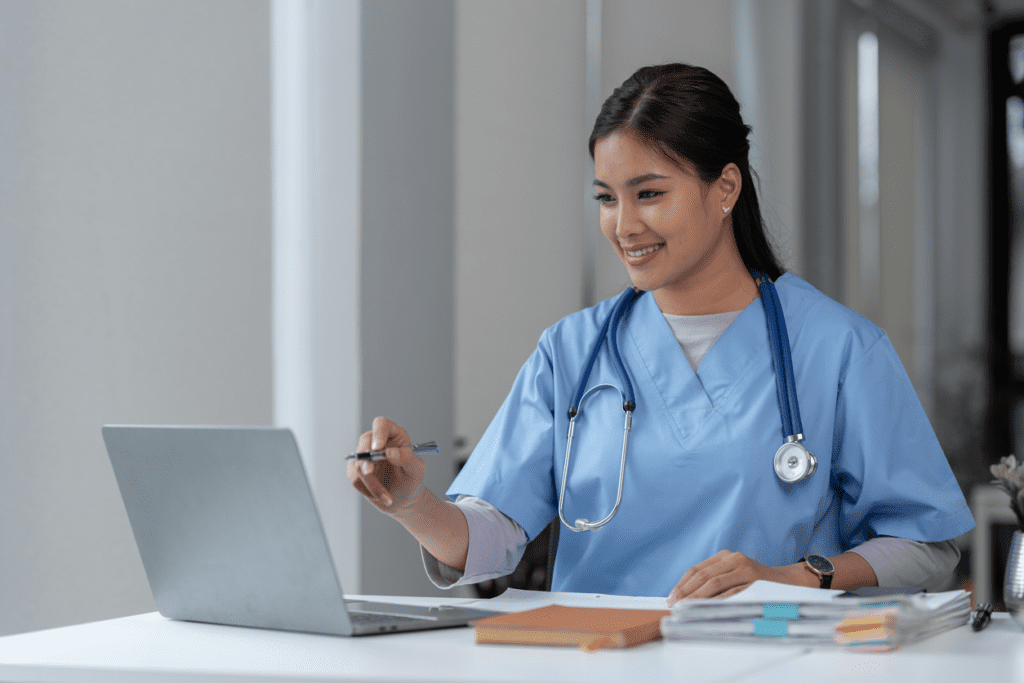
Primary.Health’s nurse practitioners provide telephonic follow-up to abnormal test results, offering building blocks for patients’ healthcare journeys.
Outside of Primary.Health, the experienced nurse practitioners (NPs) on our telehealth team see patients in hospitals, urgent care, and the ICU. However, when they call Primary.Health patients about their test results, they’re meeting these individuals where they are in their daily lives – at church, at work, or even at the grocery store.
We spoke to Marie Di Ponio-Hohl, ARNP, and Lauren Dunn, ARNP, two of nine NPs on Primary’s telehealth team, about the challenges of providing care telephonically, the benefits of neighborhood screenings and telephonic follow-up, and the unexpected conversations that result from their one-time interventions.
What is the Primary.Health NP telehealth team?
The telehealth team is led by Primary’s medical director, Aditya Chandrasekhar, MD, MPH, FACP. The NPs follow up on abnormal test results from Primary.Health-enabled neighborhood wellness clinics, where local providers screen patients for hemoglobin A1C, cholesterol, and hypertension. Primary’s clinical team reviews all results and flags abnormal findings for the NPs through Primary’s Global Case Manager. Caseload permitting, the NPs follow up by phone within an hour of patients receiving test results via email or text.
What happens during that follow-up call?
From the start, the NPs stress they are not providing an official diagnosis but rather a snapshot of the patient’s health at that moment. They then coach the patient on next steps, such as the importance of following up with a primary care physician and following a healthy diet and exercise routine. They also connect patients to resources for healthcare and healthy behaviors and provide guidance on transportation, nutrition, and occasionally housing.
‘I want to ensure patients have the tools to be successful as they are working on their health journey,” said Ms. Di Ponio-Hohl, whose nursing background is hospital-based. “Some haven’t seen a primary care doctor in 10-plus years and have no idea they have these conditions. I also have patients who have just been diagnosed; they are new to the condition and trying out how to modify their lifestyle.”
How does telephonic care differ from in-person care?
“It’s an adjustment and can be a little less natural because you don’t get to see the patient’s expressions or observe their respiratory rate during the phone call,” said Ms. Dunn, experienced in urgent care and family medicine. “Sometimes you have to follow up and ask additional questions. You also have to consider whether the patient is in the right time, place, or position to receive our counsel because of when you connect with them.”
If a patient is unable to have that conversation at that time, the NPs will arrange a better time to speak, she said. They make three attempts to connect with a patient.
What are the most commonly flagged test results?
Since the program began in July, the telehealth NPs are seeing high numbers of patients with elevated readings for hypertension, cholesterol, and HbA1c, a warning sign of diabetes. Some patients present with multiple abnormal results and sometimes may have only one abnormal level. “We tailor our counseling specifically to the individual patient’s results. High blood pressure seems to be the most common flagged result we see,” Ms. Di Ponio-Hohl noted.
“While we can’t solve all problems within a 15-minute phone call, we can provide a building block for that patient to build their care on.” Marie Di Ponio-Hohl, ARNP
What is the patients’ reaction to telephonic follow-up?
A common response from patients is “Thank you for doing the testing and taking the time to discuss this with me,” said Ms. Dunn. She hears often about providers who don’t take the time to explain and patients who find it hard to get to their provider. That’s one reason why the program is so successful, she says. “Being able to connect patients to federally qualified health centers (FQHCs), which they can visit without insurance and which also have dental clinics, social workers, and other resources, is very rewarding.”
Ms. DiPonio-Hohl concurs. “The ease of access is a huge thing for patients. Seeking healthcare can be overwhelming. Some say they’ve been wondering if they had high blood pressure but hadn’t had time to make an appointment or didn’t have health insurance or didn’t know where to begin. Then they’re at their church for an event and happen upon our health screenings.”
Can you share a memorable interaction with a patient?
“I called one patient in her 30s who was flagged as hypertensive,” Ms. DiPonio-Hohl recalls. “As I counseled her on hypertensive blood pressure guidelines and lifestyle modifications, I found out she was a few months postpartum. Our conversation switched to her mental and emotional wellbeing to make sure those aspects of her care were supported, because that can play a huge role in blood pressure rates.”
“I remember a patient that I was able to connect to an FQHC who was homeless,” adds Ms. Dunn. “That was helpful and also memorable because you realize you’re reaching such a diverse group.”
What are the key program advantages?
Both telehealth NPs agree that healthcare access and healthcare education are the main benefits of Primary.Health’s neighborhood screenings and their telephonic follow-up.
“The uninsured patients that haven’t been seen in years are a really special group of patients we’re able to catch with this program,” says Ms. DiPonio-Hohl. “And while we can’t solve all problems within a 15-minute phone call, we can provide a building block for that patient to build their care on.”
In the future, they would like to provide additional connections to smoking cessation, safe housing, and dental care. For now, both the numbers of patient screenings and telephonic caseloads are exceeding Primary’s expectations – so much so that additional NPs have been added to the telehealth team.
Empower your community or organization with Primary.Health-powered neighborhood health screenings and telephonic follow-up.
